How to Create an Open Concept Floor Plan
If you’ve watched any home buying or home design shows on television recently, you’ve probably heard the term open concept floor plan. This architectural trend has been around for decades but has dominated house plans and remodeling projects since the 1990s, giving homeowners large communal spaces that feel airy and open and make the home seem larger than it is. Open floor plans usually combine several common living spaces into one larger great room that’s ideal for family life and entertaining. Here’s everything you need to know to decide if the open concept look is right for you, and how to use this trend in your home.
What Is an Open Concept Floor Plan?
Before the 1950s, house designs were a little more formal, often centering around a long hallway, with separate rooms branching off — each with their own specific purpose. Kitchens were often found at the back of the home and were completely separate from the dining and living spaces. However, in the post-WWII era, families and their homes began to change. Families with larger numbers of children often occupied homes with smaller footprints, and the style of homes trended more toward casual rather than formal.
By this time, renowned architect Frank Lloyd Wright was already advocating for combining living rooms and dining spaces in his designs. And the changes in families and entertaining styles made opening up the kitchen to other living spaces more practical and appealing as well.
These early ideas of open floor plans remain popular in today’s home designs and are often considered the standard, especially in suburban areas. An open concept floor plan does not mean that there are no walls in the home, and spaces like bedrooms and bathrooms are generally kept separate and private.
Common Open Concept Plans

Open floor plans typically combine two or more rooms into one open space. These are the most common combinations:
- Kitchen and dining combination: The cooking and dining spaces are combined in one room, with the living room still separate. Often a kitchen island or peninsula is used as a visual divider between the spaces.
- Dining and living combination: The living room and dining room share space, with a separate room for the kitchen. Spaces may or may not be visually separated by architectural details like a railing, stairs or a sunken room.
- Kitchen/living/dining combination: Often referred to as a great room, the kitchen, living room and dining rooms can all be combined into one large space. Visual dividers may or may not be used, and the room often has a higher, vaulted ceiling.
How to Design an Open Floor Plan
Open floor plan designs are very popular choices for both new builds and renovations of older homes, but there are some things to consider before choosing this home plan style. Everything from a family’s routines and styles to specific construction considerations can all come into play when deciding if an open concept design is right for you and your home.
Open floor plans are great for young families with children because the whole family can be in the great room together and parents can keep an eye on children playing in the living space while they prepare meals in the kitchen area. They can also be great for entertaining, easing transitions from the kitchen to the dining and living areas, and allowing the host to participate more with guests. However with an open concept plan, there is a loss of privacy and noise control can be an issue, so if someone wants to escape for alone time, it may be more difficult.
Because the space is so open and everything is essentially on display, it can be a little more work to keep the great room clean and looking uncluttered. Consider if you would mind having your kitchen mess visible from the dining and living areas if guests come over. Also, with the loss of wall space, there is much less space for displaying artwork, framed photos or other wall hangings. Ultimately, it comes down to your personal style and routine when deciding to go with an open floor plan.
If you’re renovating an older home, you’ll want to consult early on with a contractor or engineer to find out what’s possible in your home. The designs will need to account for load-bearing walls and support beams, as well as the placement of home utility features like electrical systems, plumbing, heating and air vents. It isn’t always possible to carve out a huge great room in an older house, but there may be ways of opening up the space more to mimic the design and feel of an open concept home.
When you’re ready to design the open concept floor plan for your home, consider the following five tips:
- Flow of the room: Consider how the spaces are used and how you should move through the room from one zone to another. For example, the dining space should be adjacent to the cooking area so you can transport food and dishes easily. Consider distances and walking spaces between areas or specific fixtures and furniture.
- Views and room placement: On your desired property, think about the placement of large trees, gardens, views of cityscapes or countryside, as well as neighbors’ homes, alleyways and more. If you want your living room windows to have a view of your front yard, or envision a specific view from the dining table, start to build your plan around these room placements with the corresponding views. Also consider views you may want to avoid.
- Noise levels: Because the spaces are so open in an open concept plan, several family members may be in the same space, participating in different activities at the same time. Think about how you and your family might use the space and if a loud television would be distracting to someone doing homework on the dining table, or if cooking noises would be distracting to someone in the living room.
- Areas or zones: Create zones in the great room for different purposes and arrange the spaces in a way that makes the most sense for you and your family.
- Half walls and structural support: You’ll need to consider the placement of any needed structural support like partial walls, beams and posts, especially if you’re remodeling an older home. Arrange your rooms so that any needed architectural support pieces function as space dividers and you won’t end up with a post in the middle of a room or zone.
How to Decorate an Open Concept Space
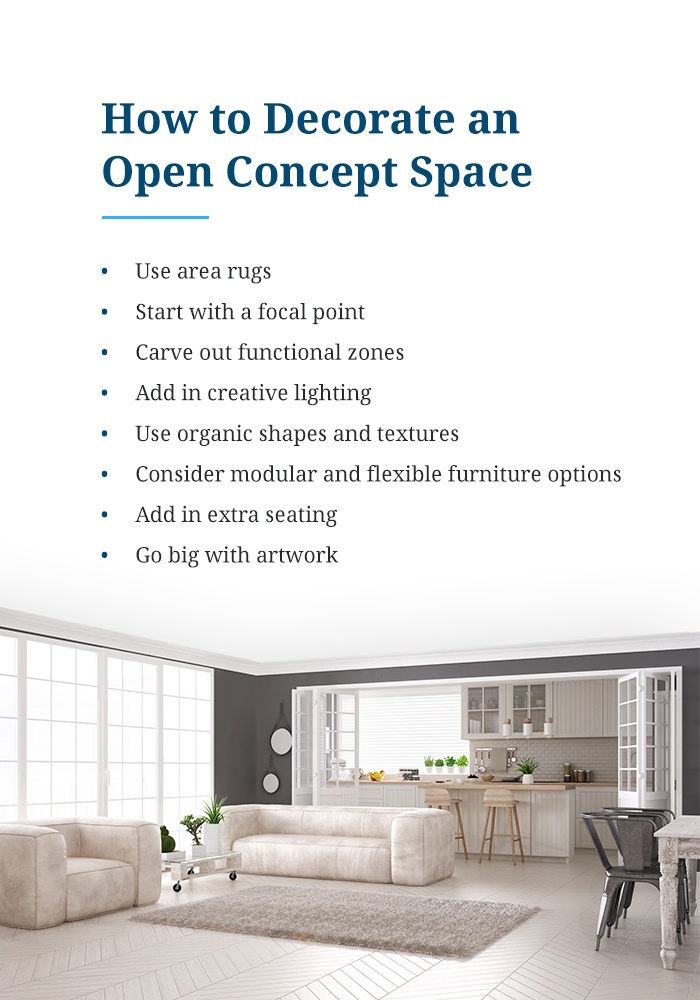
Arranging your furniture and decorating in an open house design may seem daunting at first, but with a few tips, you can easily create a warm, inviting space in your home. Try these decorating ideas for your great room:
- Use area rugs: Large rugs can easily delineate the room into different areas and create “conversation areas,” in which you can arrange your furniture for cozy conversation and entertaining. Rugs can also unify the space, even with more eclectic collections of furniture. You can find rugs in any color scheme or style, so you can have a more traditional look or go more modern.
- Start with a focal point: If you’re feeling overwhelmed with the huge space of your great room and are not sure where to start, look for a focal point. It could be a fireplace, a bank of built-in bookcases or cabinets, a gallery wall full of artwork or photos or a big window with a great view. Arrange your larger pieces of furniture around your focal point and then add in other details and smaller pieces.
- Carve out functional zones: Consider the specific ways you’ll use the space and personalize your arrangement according to these zones. Perhaps you’d like a small office area, homework station or reading nook in your living space. Build in these ideas with the furniture you want, and arrange the zones for where they will make the most sense in your layout. Other examples of this include a breakfast nook, a bar area and a coffee bar.
- Add in creative lighting: Especially in a large, multifunctional space, you’ll want to have multiple lighting options. Use overhead lights and lamps in a variety of styles, and place lighting to give you the option for bright focused light for homework, cooking or reading, and soft lighting options for intimate dinners or movie nights.
- Use organic shapes and textures: Large rooms tend to be a series of straight lines — counteract this by using organic elements like natural fibers and wooden pieces. Round and asymmetrical shaped pieces and soft textures in throw pillows and blankets also help accomplish this. Houseplants also bring some of the outdoors in, softening the space with a touch of nature.
- Consider modular and flexible furniture options: One of the best parts of having an open floor plan furniture layout is the flexibility of the larger space. Capitalize on this with the use of modular furniture units and flexible pieces that can be easily moved around to accommodate different uses of the room.
- Add in extra seating: In addition to your sofa and dining seating, have some extra options close by like bar stools and ottomans. Both can be used as extra seating for a large group gathering, or double as a side table to set a drink on. Consider other options like large poofs and throw pillows that can make lounging on the floor more comfortable.
- Go big with artwork: In a large space, lots of small pieces of dissimilar art can really get lost in the overall design. Make a statement with a large, bold work of art. Or unify your smaller pieces with the same color frames and create a stunning gallery wall.
FAQs for Open Concept Floor Plans
You may still have questions about open concept floor plans. Here are the answers to some frequently asked questions.
1. Can a Small House Have an Open Floor Plan?
Yes! Maybe when you think of open concept floor plans, only large houses come to mind. However, using an open floor plan for small spaces can work to your advantage and really open up the space, making a small home feel larger while offering added flexibility and functionality in the home’s common areas. Open concept homes can work with any size and budget.
2. How Do You Lay Out an Open Floor Plan?

With an open floor plan, there are endless options for arranging your zones and your furniture within the space. Start by arranging your zones in terms of what makes the most sense for the flow of your home. Decide where you’d like the kitchen, dining and living areas within your great room space. Add in any additional zones like a bar area or study, and then start placing furniture. Kitchen fixtures, dining table and large living room pieces like sofas and sectionals go first and then work down to smaller details. Use focal points like a great view or a fireplace to inform your design, and delineate the space with architectural details and area rugs.
3. Does the Modern Farmhouse Style Use an Open Floor Plan?
While the modern farmhouse style can easily be applied to just about any type and size of home, it works especially well with open house plans. Many modern farmhouse style homes today feature lots of shiplap, creamy colors and charming antiques used in new ways. An open concept kitchen often opens up into the dining and living areas with a large kitchen island, complete with barstools. You can find open floor plan ideas for modern farmhouse style — or just about any other style you prefer.
4. What Are the Benefits of an Open Floor Plan?
Open concept house plans offer many advantages over other styles of home plans:
- Makes any home feel larger: Combining kitchen, dining and living spaces makes for a much larger room, and these great rooms often have a higher ceiling, giving the illusion of an even larger space. Having a larger room like this can make even a smaller house feel bigger.
- Lots of natural light: The absence of excess interior walls means you can have more windows in your great room and access to natural light from more sides and angles of the room. This contributes to the light, airy quality of the room, as well as adding in more views of your outdoor spaces.
- Great for family life and entertaining: The larger, multifunctional space of the open concept floor plan makes it easy for your family to hang out together and for parents to keep an eye on young children. It is also great for entertaining because the host can more easily interact with guests, even while prepping food in the kitchen. It’s easier for family members and guests to gather in any of the zoned areas while still feeling connected.
- Flexibility: The open floor plan offers the ultimate in flexible options and multipurpose spaces. It’s easy to reconfigure the space, and re-arrange your furnishings to accommodate your needs at the moment, adjusting for all sorts of family and entertaining situations.
Search Open Concept House Plans Today

Are you ready to find the open concept home of your dreams? Browse hundreds of open concept floor plans, as well as many other available styles, at Family Home Plans today. We partner with more than 150 floor plan designers to give you the best variety of house plan options all in one location. Our house plans are categorized and easily searchable, so you’ll quickly find the right plans for you. Find your dream home at Family Home Plans.

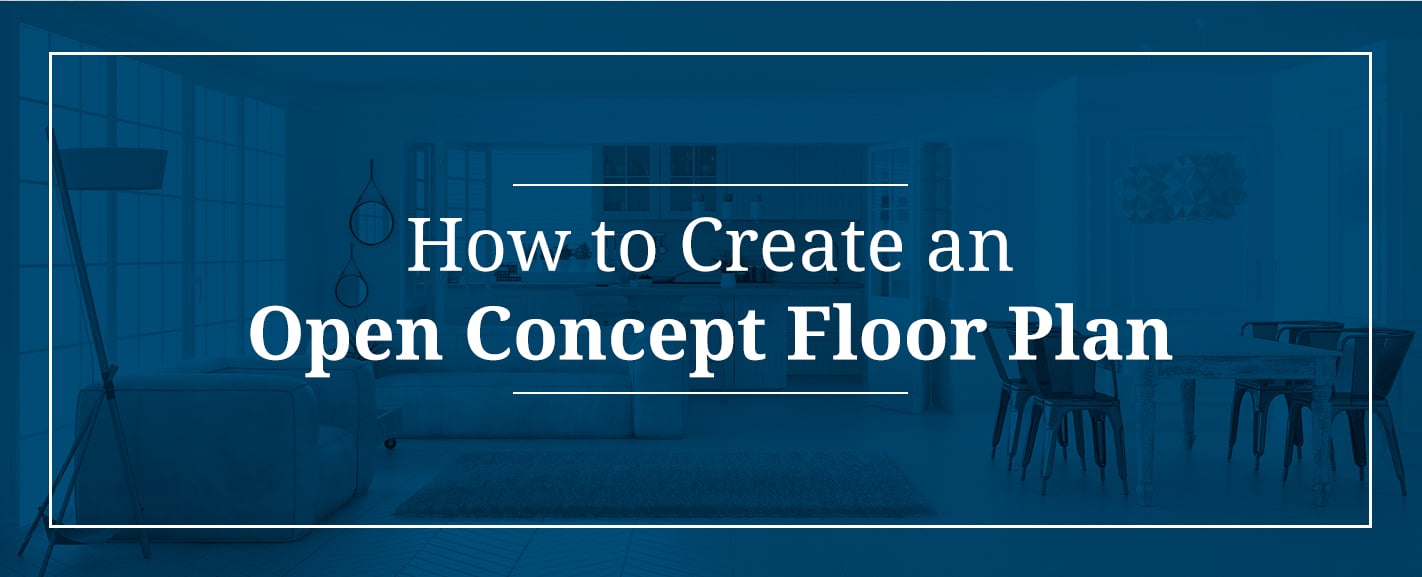
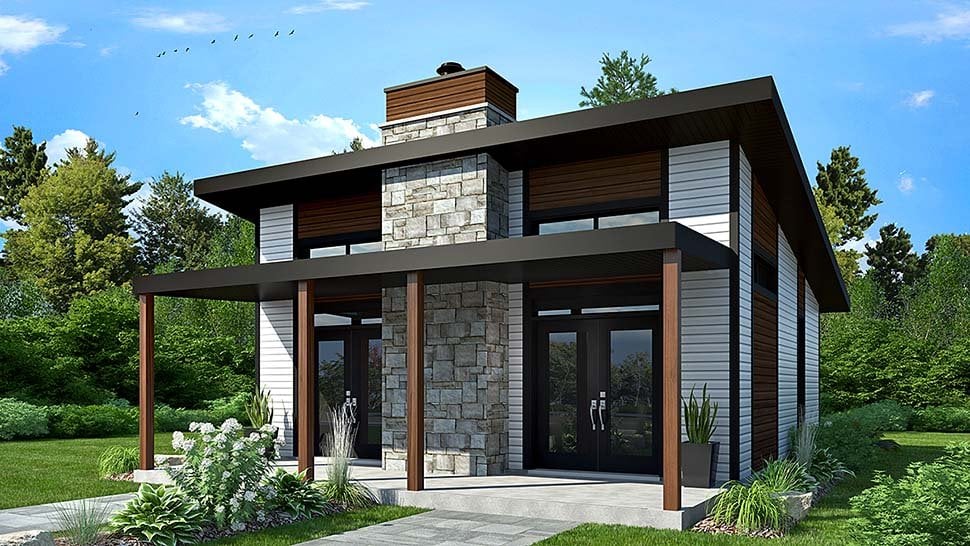

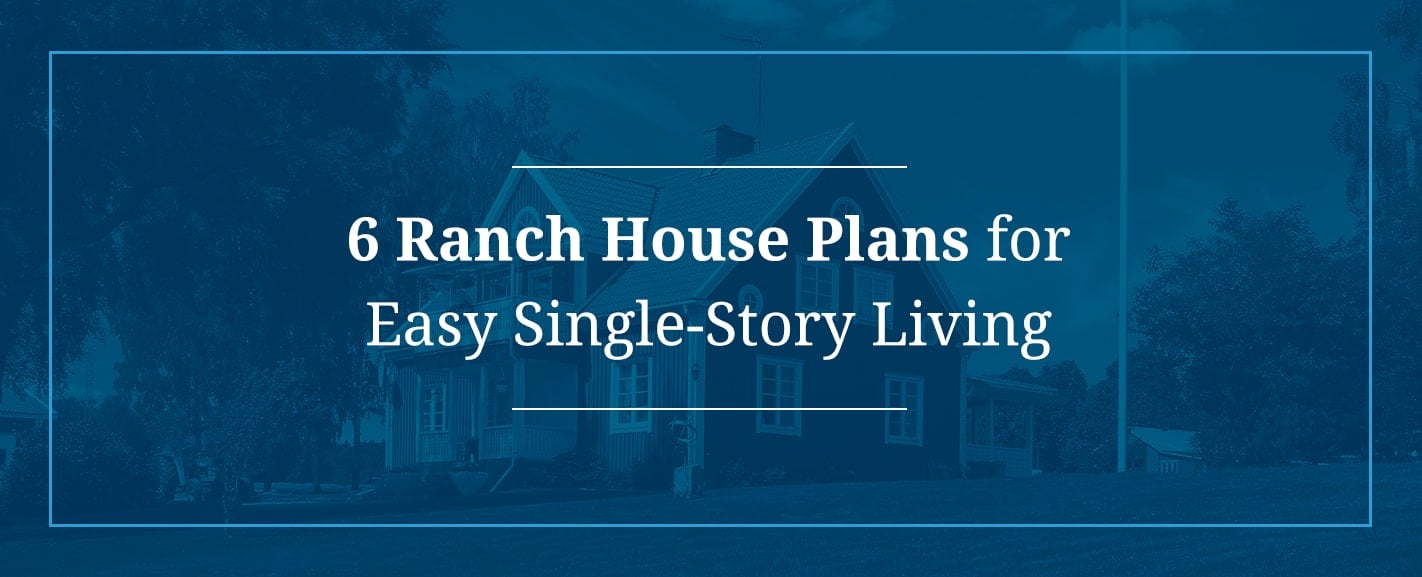
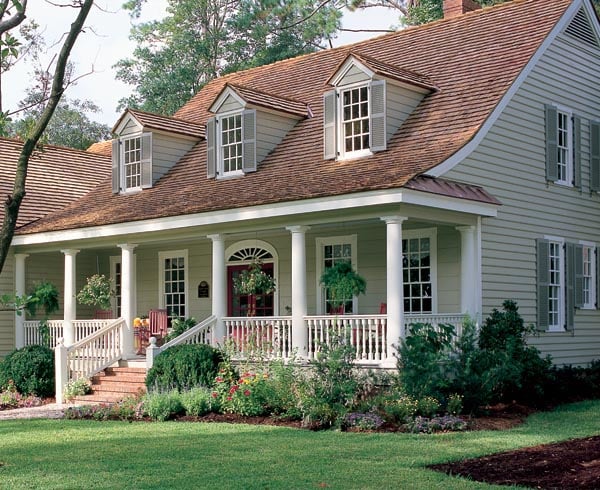

Leave a Reply